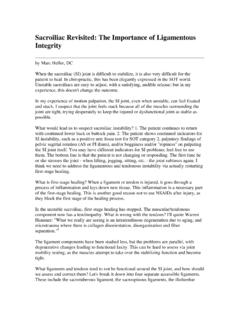Transcription of Sacroiliac Instability: An Overview
1 1 Sacroiliac instability : An OverviewMarc Heller, DC,practices in Ashland, Ore. He can be contacted at For more information, including a brief biography, a printable version of this article and a link to previous articles, please visit Dr. Heller s columnist page online: the years, I have noticed that the most difficult Sacroiliac (SI) patients have hypermobility, either obvious or hidden. If a joint is hypermobile, traditional chiropractic adjusting (high-velocity, low-amplitude) is not likely to help in the long term, even though these patients are easy to adjust and may get a few hours or a day of relief. The typical pattern is that they get relief from adjusting, but never hold the adjustment.
2 Another scenario: Patients get relief and feel better, but then trivial trauma, a sudden twist or sitting too long, throws the SI off again, and they return with a recurrence of their low back and/or leg pain. I have been writing about various aspects of the Sacroiliac for a long time. This article is an Overview or review. To utilize it best, visit ; you'll find many of the other articles I've written on SI over the years, including those referenced at the end of this article. You can also visit my columnist page ( ) and type in " Sacroiliac " in the search box. I will share a couple of useful pieces directly in this article, including my favorite physical exam test for instability and the basic principle compression to use for adjusting an unstable do you determine that the joint is unstable?
3 What you want to see is the preponderance of the evidence: several signs that together give you this indication. Youcan get this from a classic history (improved low back pain from manipulation, but the relief is short lived; and if the condition is recurrent). Women whose lower back pain started in pregnancy or at birth often have SI instability . You can start to suspect instability based on a global exam for laxity. Check range of motion at their thumbs and wrists, and see if they have an overall pattern of hypermobility, which will tend to lead to ligament problems in the SI. You can deeply palpate on the side of theilium, where the gluteus medius posterior and gluteus maximus fibers originate, and may find exquisite tenderness here.
4 You can deeply palpate the ligaments of the SI region, including the sacrotuberous, the long Sacroiliac , and the interosseous SI ligaments, as well as the iliolumbar ligaments. When these are tender, they usually indicate SI hypermobility. As you get better at palpating for instability , you will begin to notice a qualitative difference in lax or damaged ligaments: a lack of tone. You canmotion test or spring the joint, testing for excessive mobility. I ve illustrated my favorite test for this below. For 2this supine test, use your whole body, shifting toward the patient s feet, using the leverage of the patient s bent knee to open the joint.
5 I like this test as it levers open the SI joint, and after you ve tried it on a few patients, you will appreciate the difference between the feel of a normal or fixated joint, and the feel of a hypermobile joint. If you just apply prone posterior to anterior pressure over the SI, you can easily get fooled. The body attempts to compensate for the hypermobility by tightening every possible structure that it can. I missed SI hypermobility almost completely for the first 12 years of my chiropractic career. You cannot find something you are not looking for. There are a series of procedures that need to be done to stabilize a chronic, unstable, hypermobile SI joint.
6 I ll outline them here, providing links to other articles I ve written on these methods. ManipulationIf the joint is hypermobile, high-velocity low-amplitude manipulation doesn t make a lot of sense. You are moving an already hypermobile joint. It is possible that the opposite SI is hypomobile. The osteopaths divide their methods into iliosacral and Sacroiliac manipulations; I think this makes sense. Get the iliosacral joint lined up properly and then address the sacrum. (A few years back, I wrote a series of three articles about low-force iliosacral ) Conceptually, if the joint is unstable and separated, you need to think in terms of compression adjustments.
7 Charles Blum, author of Sacro-Occipital Technique s Category Two : A Remedy for Fixated Thinking, featured in the Sept. 1 issue of Dynamic Chiropractic,4acknowledged this in reviewing the SOT model for category 2 and explaining the use of the SOT blocks. I ve illustrated a prone way to correct the SI with compression below. You can use many different methods aimed at compression 3aimed at closing the joint. You can use recoil or engage, listen, follow (ELF), counter-strain technique (done prone, bringing the leg into extension), or side-posture adjusting in the direction of compression. For the sacrum, you can visualize it as a problem in relation to the ilium or L5; you can visualize it as an intraosseous key is that the sacrum should not feel rigid, stuck and tender.
8 Your low-force manipulation should result in a better alignment and a better feel to the sacrum. Typically, a small area of the sacrum, left or right, and at a particular level, will feel most stuck. Don t forget lumbar facet joints and midline lumbar compression issues, as well as the rest of the spine. In the lower extremity, consider the hip joints, knees, ankles and feet. Another significant area is the lower abdomen. Post-surgical scar tissue and visceral mobility issues can affect the SI most critical and most basic rehabilitation tool is establishing core stability. The basic tests of the core, such as variations on the active straight-leg-raise test, assess whether there is excessive SI motion on recruitment of the core muscles.
9 The concept here is simple: If the patient fails these tests, their pelvis is moving incorrectly and they are continually re-injuring themselves doing the most basic, everyday motions of their concept is the essence of force closure. Are the main stabilizing muscles doing their job? If you can enroll the patient in this process, they will have an excellentchance of success. If you cannot get the patient to pay attention, or if you don t know how to teach core stabilization, your odds of success diminish rapidly. I like to teach my patients basic SI self-correction think of these as self-mobilization movements. They really are not for a specific muscle, but are a valuable tool for the patient.
10 4I am always trying to find what exercises give the patient relief. For some SI patients, it may be one of the piriformis stretches; for others, the SI self-correction; for others, a simple five-minute walk. Other muscles around the pelvis also can play significant roles. The gluteus medius and maximus, the hamstrings and quadriceps can need attention. Is the patient sedentary? I like to recommend a basic pedometer and see how many steps they are taking in a day. A goal of 10,000 steps a day is great, but if they sit for eight hours a day, this may be hard to achieve. Walking is one of the best exercises for the SI. Sitting in a car for a long journey, especially without frequent breaks, is one of the worst insults to the SI.











